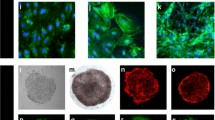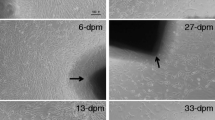Abstract
Establishing new somatic cell cultures has raised significant attention as an effective and convenient way to preserve genetic samples for different applications. Although many lines have been established in model animals, none derived from six-banded armadillo species is currently available. We report the successful isolation and characterization of fibroblasts from six‐banded armadillos, evaluating the cell quality after extended culture and cryopreservation. Initially, we collected ear skin from five captive adult individuals and identified fibroblast lines by morphology, karyotyping, and immunophenotyping assays. The isolated fibroblasts were evaluated after several passages (fourth, seventh, and tenth passages) and cryopreservation by slow freezing. Cell morphology, viability, metabolism, proliferative activity, mitochondrial membrane potential, and apoptosis levels were analyzed. The skin explants had great adhesion, and cell outgrowth could be seen after 3–6 d. The cells were verified as fibroblasts at the fourth passage by vimentin expression and normal karyotype (2n = 58). The viability remained high (> 87%) and constant from the fourth to the tenth passage (p > 0.05). The passages did not change the cell morphology and metabolic and growth rates. Moreover, cryopreservation did not affect most evaluated parameters; post-thawed cells maintained their viability, growth, metabolism, and apoptosis levels. Nevertheless, cryopreservation increased mitochondrial membrane permeability and cell population doubling time compared to non-cryopreserved cells (p < 0.05). In summary, viable fibroblasts can be obtained from six-banded armadillo skin while conserving their quality as the number of passages increases and featuring few changes after cryopreservation.






Similar content being viewed by others
Data availability
Data may be made available upon reasonable request to the corresponding author.
References
Abba AM, Lima E, Superina, M (2014) Euphractus sexcinctus. The IUCN Red List of Threatened Species 2014:e.T8306A47441708. https://doi.org/10.2305/IUCN.UK.2014-1.RLTS.T8306A47441708.en. Cited 18 Dec 2023.
Barbosa RAP, Oliveira MA (2022) New records and range extension of Euphractus sexcinctus (Linnaeus, 1758) (Cingulata, Chlamyphoridae) in Rondônia state, Brazil. Check List 18:265–268. https://doi.org/10.15560/18.2.265
Bjørneset J, Blévin P, Bjørnstad PM, Dalmo RA, Goksøyr A, Harju M, Limonta G, Panti C, Rikardsen AH, Sundaram AYM, Yadetie F, Routti H (2023) Establishment of killer whale (Orcinus orca) primary fibroblast cell cultures and their transcriptomic responses to pollutant exposure. Environ Int 174:107915. https://doi.org/10.1016/j.envint.2023.107915
Borges AA, Lima GL, Queiroz Neta LB, Santos MVO, Oliveira MF, Silva AR, Pereira AF (2017) Conservation of somatic tissue derived from collared peccaries (Pecari tajacu Linnaeus, 1758) using direct or solid-surface vitrification techniques. Cytotechnology 69:643–654. https://doi.org/10.1007/s10616-017-0074-7
Borges AA, Lira GPO, Nascimento LE, Queiroz Neta LB, Santos MVO, Oliveira MF, Silva AR, Pereira AF (2018) Influence of cryopreservation solution on the in vitro culture of skin tissues derived from collared peccary (Pecari tajacu Linnaeus, 1758). Biopreserv Biobank 16:77–81. https://doi.org/10.1089/bio.2017.0090
Borges AA, Lira GPO, Nascimento LE, Santos MVO, Oliveira MF, Silva AR, Pereira AF (2020) Isolation, characterization, and cryopreservation of collared peccary skin-derived fibroblast cell lines. PeerJ 8:e9136. https://doi.org/10.7717/peerj.9136
Dua S, Sharma P, Saini M, Rawat N, Rajendran R, Bansal S, Wakil AM, Beniwal M, Parashar A, Bajwa KK, Selokar NL, Kumar R, Kumar D, Yadav PS (2021) Cryobanking of primary somatic cells of elite farm animals—A pilot study in domesticated water buffalo (Bubalus bubalis). Cryobiology 98:139–145. https://doi.org/10.1016/j.cryobiol.2020.11.014
Fernandes DP, Praxedes ÉA, Freitas CIA, Pereira AF (2023a) Ex situ approaches for the conservation of genetic resources in the superorder Xenarthra. Biopreserv Biobank 21:225–232. https://doi.org/10.1089/bio.2021.0182
Fernandes DP, Praxedes EA, Viana JVS, Aquino LVC, Rodrigues LLV, Moura YBF, Oliveira MF, Freitas CIA, Pereira AF (2023b) Influence of cryopreservation techniques and low concentrations of permeating cryoprotectants on the conservation of ear cartilage and skin derived from six-banded armadillos (Euphractus sexcinctus Linnaeus, 1758). Cryobiology 113:104788. https://doi.org/10.1016/j.cryobiol.2023.104788
Guo C, Sun W, Cheng W, Chen N, Deng C, Xu H, Wu C, Lv Y (2022) Isolation and characterization of Staphylococcus saprophyticus responsible for death of two six-banded armadillos (Euphractus sexcinctus). Res Sq 1:1–15. https://doi.org/10.21203/rs.3.rs-2276185/v1
Jenuit M, Zainuddin ZZ, Payne J, Ahmad AH, Yusof AM, Isa MLM, Ibrahim M (2021) Establishment and cryopreservation of fibroblast cell line from a Sumatran rhinoceros (dicerorhinus sumatrensis). J Sustain Sci Manag 16:85–98. https://doi.org/10.46754/jssm.2021.06.008
Lira GPO, Borges AA, Nascimento MB, Aquino LVC, Moura LFM, Silva HVR, Pereira AF (2022) Morphological, ultrastructural, and immunocytochemical characterization and assessment of puma (Puma concolor Linnaeus, 1771) cell lines after extended culture and cryopreservation. Biopreserv Biobank 20:557–566. https://doi.org/10.1089/bio.2021.0117
Liu Y, Chen J, Feng T, Hou R, Cai Z, Wang D, Zhang M, Li Y, Chen Y, An J (2022) The establishment of giant panda (Ailuropoda melanoleuca) fibroblast cell line. In Vitro Cell Dev-an 58:194–198. https://doi.org/10.1007/s11626-022-00668-9
Magalhães LC, Bhat MH, Freitas JL, Melo LM, Teixeira DI, Pinto LC, Freitas VJF (2017) The effects of cryopreservation on different passages of fibroblast cell culture in brown brocket deer (Mazama gouazoubira). Biopreserv Biobank 15:463–468. https://doi.org/10.1089/bio.2017.0060
Malik P, Mukherjee S, Mukherjee TK (2023) Microbial contamination of mammalian cell culture. In: Mukherjee TK, Malik P, Mukherjee S (eds) Practical Approach to Mammalian Cell and Organ Culture. Springer, Singapore, pp 187–231. https://doi.org/10.1007/978-981-19-1731-8_5-1.
Mehrabani D, Booyash N, Aqababa H, Tamadon A, Zare S, Dianatpour M (2016) Growth kinetics, plasticity and characterization of hamster embryonic fibroblast cells. Ital J Zool 83:306–311. https://doi.org/10.1080/11250003.2016.1194487
Mehrabani D, Mahboobi R, Dianatpour M, Zare S, Tamadon A, Hosseini SE (2014) Establishment, culture, and characterization of guinea pig fetal fibroblast cell. Vet Med Int 2014:1–5. https://doi.org/10.1155/2014/510328
Oliveira LRM, Praxedes ÉA, Silva MB, Ribeiro LR, Silva HVR, Pereira AF (2021) Comparative effect of cryoprotectant combinations on the conservation of somatic cells derived from jaguar, Panthera onca, towards the formation of biologic banks. An Acad Bras Cienc 93:e20190314. https://doi.org/10.1590/0001-3765202120190314
Paglia AP, Fonseca GA, Rylands AB, Herrmann G, Aguiar LM, Chiarello AG, Patton JL (2012) Lista Anotada dos Mamíferos do Brasil 2ª Edição/Annotated Checklist of Brazilian Mammals 2nd Edition. Conservation International, Arlington
Praxedes ÉA, Borges AA, Santos MVO, Pereira AF (2018) Use of somatic cell banks in the conservation of wild felids. Zoo Biol 37:258–263. https://doi.org/10.1002/zoo.21416
Praxedes ÉA, Silva MB, Oliveira LRM, Viana JVS, Silva AR, Oliveira MF, Pereira AF (2021) Establishment, characterization, and cryopreservation of cell lines derived from red-rumped agouti (Dasyprocta leporina Linnaeus, 1758)–A study in a wild rodent. Cryobiology 98:63–72. https://doi.org/10.1016/j.cryobiol.2020.12.006
Rodrigues LL, Moura YB, Viana JVS, Praxedes EA, Oliveira LR, Silva HVR, Pereira AF (2023) Comparison between concentration and type of intracellular cryoprotectants and the presence of sucrose for cryobanks of somatic cells derived from captive Pumas. Zoo Biol 42:440–448. https://doi.org/10.1002/zoo.21748
Rodrigues TF, Mantellatto AM, Superina M, Chiarello AG (2019) Ecosystem services provided by armadillos. Biol Rev 95:1–21. https://doi.org/10.1111/brv.12551
Santos PS, Bocchiglieri A, Chiarello AG, Paglia AP, Moreira A, Souza AC, Abba AM, Paviolo A, Gatica A, Medeiro AZ (2019) Neotropical xenarthrans: a data set of occurrence of xenarthran species in the neotropics. Ecology 100:e02663. https://doi.org/10.1002/ecy.2663
Selokar NL, Sharma P, Krishna A, Kumar D, Kumar D, Saini M, Yadav PS (2018) Establishment of a somatic cell bank for Indian buffalo breeds and assessing the suitability of the cryopreserved cells for somatic cell nuclear transfer. Cell Reprogr 20:157–163. https://doi.org/10.1089/cell.2017.0066
Sharma R, Sharma H, Ahlawat S, Aggarwal RAK, Vij PK, Tantia MS (2018) First attempt on somatic cell cryopreservation of critically endangered Camelus bactrianus of India. Gene Rep 10:109–115. https://doi.org/10.1016/j.genrep.2017.11.007
Siengdee P, Klinhom S, Thitaram C, Nganvongpanit K (2018) Isolation and culture of primary adult skin fibroblasts from the Asian elephant (Elephas maximus). PeerJ 6:e4302. https://doi.org/10.7717/peerj.4302
Sousa PC, Santos EA, Silva AM, Bezerra JA, Souza AL, Lima GL, Silva AR (2016) Identification of ultrastructural and functional damages in sperm from six-banded armadillos (Euphractus sexcinctus) due to cryopreservation. Pesq Vet Bras 36:767–774. https://doi.org/10.1590/S0100-736X2016000800015
Sreekumar E, Janki MBV, Arathy DS, Hariharan R, Premraj CA, Rasool TJ (2007) Molecular characterization and expression of interferon-γ of Asian elephant (Elephas maximus). Vet Immunol Immunopathol 118:75–83. https://doi.org/10.1016/j.vetimm.2007.04.012
Superina M, Abba AM (2018) Family Chlamyphoridae (Chlamyphorid armadillos). In: Wilson DE, Mittermeier RA (eds) Handbook of the mammals of the world -, vol 8. insectivores, sloths and colugos. Lynx Edicions, Barcelona, pp 48–73
Teixeira JVDS, Santos JSD, Guanaes DHA, Rocha WDD, Schiavetti A (2020) Uses of wild vertebrates in traditional medicine by farmers in the region surrounding the Serra do Conduru State Park (Bahia, Brazil). Biota Neotrop 20:e20190793. https://doi.org/10.1590/1676-0611-BN-2019-0793
Wang T, Li Z, Zheng D, Liu W, Huang P, Zeng Z, Xu C, Wang B, Wei J (2020) Establishment and characterization of a fibroblast cell line from postmortem skin of an adult Chinese muntjac (Muntiacus reevesi). In Vitro Cell Dev-an 56:97–102. https://doi.org/10.1007/s11626-019-00422-8
Yu FJ, Zeng CJ, Zhang Y, Wang CD, Xiong TY, Fang SG, Zhang HM (2015) Establishment and cryopreservation of a giant panda skeletal muscle-derived cell line. Biopreserv Biobank 13:195–199. https://doi.org/10.1089/bio.2014.0073
Acknowledgements
This study was financed in part by the Coordenação de Aperfeiçoamento de Pessoal de Nível Superior – Brasil (CAPES, Financial Code 001), Conselho Nacional de Desenvolvimento Científico e Tecnológico (CNPq, no. 309078/2021-0), and Pró-Reitoria de Pesquisa e Pós-Graduação (PROPPG)/UFERSA (no. 35/2021). AR Silva, and AF Pereira were recipients of CNPq grants.
Author information
Authors and Affiliations
Corresponding author
Ethics declarations
Conflict of interests
The authors declare no conflict of interests.
Rights and permissions
Springer Nature or its licensor (e.g. a society or other partner) holds exclusive rights to this article under a publishing agreement with the author(s) or other rightsholder(s); author self-archiving of the accepted manuscript version of this article is solely governed by the terms of such publishing agreement and applicable law.
About this article
Cite this article
Fernandes, D.P., Praxedes, É.A., da Silva Viana, J.V. et al. Long-term preservation of established fibroblast lines from six‐banded armadillos (Euphractus sexcintus, Linnaeus, 1758) by extended passage and cryopreservation. In Vitro Cell.Dev.Biol.-Animal 60, 266–277 (2024). https://doi.org/10.1007/s11626-024-00871-w
Received:
Accepted:
Published:
Issue Date:
DOI: https://doi.org/10.1007/s11626-024-00871-w




